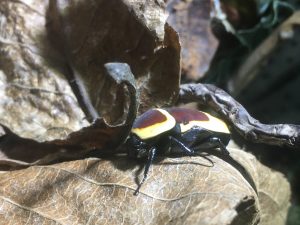Copyright 2021 Evolution Reptiles
All rights reserved.
Copyright 2025 Evolution Reptiles
All rights reserved.
All rights reserved.
Most people will recognise this species in its larval form, when they are sold as ‘fruit beetle grubs’ as food for larger lizards, spiders and the like. If a little time is taken to keep them through a whole life cycle, they are actually rather engaging and charming little pets!
Attractively patterned in gold and brown, the sun beetle hails from tropical Africa, where it is usually found amongst the leaf litter of the forest floor. One of the easiest beetle species to keep and breed, both the adults and the larvae can be fed on a wide range of fruit and fruit substitutes, and as long as there is enough substrate to burrow in they are happy.
The adults grow to around 3cm in length, and are quite accomplished flyers; their sense of direction isn’t great, and they tend to fly into walls. They do like an enclosure with some height, and unlike many insects appear to relish being provided with UV light. A low strength compact UV bulb suspended over the enclosure will ensure that you see your beetles more often, and the additional heat will stimulate their activity as well. The beetles do spend some time buried in the substrate, so don’t worry if you look into your enclosure and there are no beetles to be seen – they are still there!

Feeding is simple. Any fruit can be offered, just make sure that it is removed before it starts to rot or you may be overrun with fruit flies. Mango, kiwi, orange, banana, apple and strawberry are all good foods; make sure to vary them regularly so that your beetles obtain a balanced diet. There are also beetle jelly foods available, and these make an excellent diet as there is no chance of any pesticide residue that might affect your pets.
Breeding is simple, and as long as you have happy beetles you will end up with grubs! These are a yellowish white with a brown head, and are relished as a treat food by many lizards and birds; they can reach up to 4cm and have quite strong jaws, so not great to handle. When the grubs are ready to turn into adult beetles they will pupate, and build a cocoon for themselves out of the substrate they live in. The adult beetles will lay their eggs in the substrate, and it takes about four months from egg to beetle.
An enclosure should be at least 20x20x30cm with a deep enough substrate for the beetles and grubs to burrow in. There are special beetle mixes available these days, but a mix of coir fibre, soil and leaf litter will keep them happy. A little rotting wood buried in the substrate will make them feel right at home! Keep the substrate damp but not wet, and give the enclosure a spray down every other day. The beetles will get most of their moisture from their food, but they do like to drink from droplets on the leaves.
Copyright 2021 Evolution Reptiles
All rights reserved.